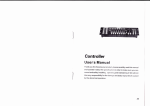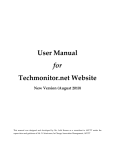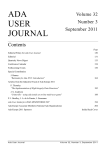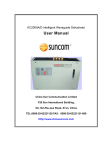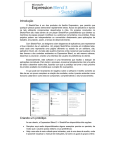Download Ethical and Env. Analysis
Transcript
ECE 477 Digital Systems Senior Design Project Spring 2007 Homework 12: Ethical and Environmental Impact Analysis Due: Friday, February 23, at NOON Team Code Name: ________Digi-Spi_______________ Group No. __1__ Team Member Completing This Homework: _______Karl Herb___________________ e-mail Address of Team Member: __kherb_____ @ purdue.edu NOTE: This is the last in a series of four “professional component” homework assignments, each of which is to be completed by one team member. The completed homework will count for 20% of the individual component of the team member’s grade. The body of the report should be 3-5 pages, not including this cover page, references, attachments or appendices. Evaluation: Component/Criterion Score Multiplier Introduction and Summary 0 1 2 3 4 5 6 7 8 9 10 X1 Ethical Impact Analysis 0 1 2 3 4 5 6 7 8 9 10 X3 Environmental Impact Analysis 0 1 2 3 4 5 6 7 8 9 10 X3 List of References 0 1 2 3 4 5 6 7 8 9 10 X2 Technical Writing Style 0 1 2 3 4 5 6 7 8 9 10 X1 TOTAL Comments: Comment from the grader will be inserted here. Points ECE 477 Digital Systems Senior Design Project Spring 2006 1.0 Introduction The “Digi-Spi” is a remote listening device that monitors conversations. To accomplish this end, the device uses a multiple of peripherals. Connecting into the PCB are a Wi-Fi module for internet access, a Bluetooth module, a GSM module, a microphone input, and a headphone output. This selection of peripherals in addition to a microcontroller presents a variety of communication specifications. With the modules are inherit environmental and ethical issues. The device is recording data, and therefore its reuse and potential misuse is important. Ethically, the use of fail safe, operation use, and electrical characteristics are of importance. Environmentally, various pollutants and power utilizations are considered. The following paper divulges these concerns and analyzes the ethical and environmental impact of the Digi-Spi remote listening device. 2.0 Ethical Impact Analysis The goal of the Digi-Spi is to be a listening device. The natural ethical question stemming from this is the use of recorded voice data. This is a current topic seen even in the media, with the current United States government security measures under question. Furthermore, the data being recorded is streamed in real time over the air using a cell phone or computer connection. The data is then stored in persistent storage in a well-defined format within a portable and scaleable component: the SD card. The data is time stamped, meaning the voice recording can be traced to when it was said. This ability to stream and record what was said when can be of positive use. Ethically, it is important to examine how this utilization can be a negative aspect. To solve this ethical issue, restricted access and operating environment of the device is essential. When the target market of the device under development (if it would later be produced) is to be a toy or amateur novelty application, a liability for ‘clean’ use does not exist. When the device is targeted for professional or military use, the device would need to be more secure. Fortunately, the device is not targeted for this market, and therefore a heightened level of security is not essential. If the device was to be made more secure, it would ideally have a single phone number, have a lock on the SD card, have its wireless network uniquely encrypted, and have a digital lock on the control panel. This goes beyond the scope of the current project, and therefore will not be considered. Hence, in order to avoid this potential issue of using a -1- ECE 477 Digital Systems Senior Design Project Spring 2006 non-secure and amateur device in a secure or professional area, a warning label must be placed on the device saying it is not intended for any professional or military use, but solely as a novelty. This would also be stated in the user manual. The alleviation of the operating environment is consistent with the IEEE code of ethics that states in their second requirement that a conflict of interest must be avoided [1]. The addressing of the ethical issue is removing a conflict of interest. In addition, the manufacturer and even the developers of the device are held responsible when the component is used in a negative manner. Therefore, in the user manual, there will be a statement claiming that the developers are not reliable for any harm brought upon through a non-ethical use of the device. This would even include reusing the data on a computer to manipulate it, or hold it against a person. Adding to the military and professional use discussion, the device is not designed with the correct rigorous environment use. Ethically, a device used in a professional environment needs to be fail safe and highly portable to operate under a variety of temperature and unique conditions. In addition its software design needs to be secure, scaleable, and safe from tampering. A Military Embedded Articles states that the C language is not favorable for the development of secure applications [2]. Therefore, the use of this device beyond a novelty must be discouraged. Therefore, in addition to the warning labels and user manual outlined above, the device has been designed to fit into a common household item and function off of a wall wart. This encourages a more everyday use, instead of a uniquely focused application. In addition, if the product was to be marketed, the system would be sealed and unable to be opened (outside of removing the SD card). This way the PCB could not be removed and used in a different application. To prevent this issue, the user manual will state that the developers are not responsible when the PCB is used in a different application than what it was designed for. Finally, the ethical issues of electricity, power, and electrical signals need to be considered. The normal electrical issue including voltage and group apply, and therefore, the PCB is enclosed in a common household device, such as a lamp, to protect it from the elements. As stated above, if the device would be manufactured, it would be sealed. This not only deters reuse, but keeps the device clean and reduces a risk of electrical injury. The amount of power used by the device can rise to nearly 3.5W. Therefore, a warning label will be placed on the device, and in the user manual. This amount of power dissipation is unlikely as devices are chose to operate much lower than their maximum operation, and this statistic is the absolute -2- ECE 477 Digital Systems Senior Design Project Spring 2006 maximum. The worst issue is electro-magnetic-fields (EMF) from the GSM and Wi-Port. In fact, an EE Times article states that “pulsed electromagnetic energy generated by electronic devices causes stress to the human body” [3]. The EMF generated is part of the Wi-Port and GSM module, and therefore their operation is kept within there limits. To aid with this, a warning label will be placed on the device noting the EMF factor and in the user manual a note will be made removing us from any EMF issues as these are due to the peripherals we have, and not to our own components. 3.0 Environmental Impact Analysis This device is designed to be a novelty item used with a wall-wart and not for a specific portable or professional application. Therefore, the worst environmental impacts are the PCB board and noise pollution. During manufacturing the environmental impact of the device is due to the PCB manufacturing. PCB manufacturing consists of etching of the traces onto a metal. This uses numerous natural resources including metals (copper, gold, nickel, and tin) and water [4]. In addition, the process “generates large amounts of metal-bearing effluent solutions that require expensive treatment before they are discharged into the environment” [4]. Fortunately, this product is only a prototype, but if the product is put into development, it would be necessary to consider the cost of alternative PCB manufacturing technologies that reuse the manufacture metals and reduce pollutions. This large amount of unused materials is less likely to be released into the environment, and a portion can be reused for another PCB. The other side of this would be the economic benefit of using a cleaner PCB manufacture, but this discussion is an environmental focus. Once the PCB is etched and populated it is operational. During the operational phase the main environmental impact of the product is EMF from the wireless modules. This so called “eSmog”, is not only ethical, but environmental in the sense that it harms living organisms, including humans, in the environment [3]. The radiation of EMF can cause “breaks in DNA sequences and inhibit the body’s ability to repair these breaks” [3]. For this reason, there are the ethical liability and labels mentioned above. These also double to warn the user that the device can be harmful. Unfortunately, the data for EMF harm is still not fully backed, but it could be a potential risk. In addition, our device is small and only uses a minute internet, Bluetooth, and cellular module. These will not come in close proximity to a human as a cellular phone would. -3- ECE 477 Digital Systems Senior Design Project Spring 2006 If this environmental need would be addressed and the device is manufactured, in addition to the labeling it would be best to include an optional Ethernet connection with the ability to disable the wireless. Overtime the device will breakdown, and when it is time for disposable, it would be best to recycle the device. This is a difficult process as is evident from a military document summary that states PCBs “generally have no usefulness once they are removed from the electrical component in which they were installed” [5]. In our case, this would be when it is no longer powered and the board has burnt-out. The large amounts of lead and the energy used to make the device should not be wasted. Instead, companies exist that recycle the device, such as NEC Corp. in Japan [6]. This plant separates the components of the PCB and materials, including copper, are reclaimed from the board. This is in the hopes of reusing the materials. Clearly, this is not an inexpensive procedure, and for a single board, this would not be the best solution. For a set of manufactured boards, it would be ideal. For this reason, the user manual will contain a return to manufacturer label for proper disposal and a warning label will be on the package as well. This way the PCB can be recycled, or taken care of if another avenue exists at the time. For disposal of the remaining device, i.e. the lamp and plastics, it would be best to recycle these items. Unfortunately, much of the materials are thrown away in American society, but it would be best to reuse any parts, such as screws and spacers, for future use. Therefore, the disposal of the entire package will be marked as returnable to the manufacturer for proper disposal. In order to not be offensive and incur any costs, the warning label is only a suggestion for a marketable product. But, this is a single prototype, and therefore the return to manufacturer is a demand. 4.0 Summary As is shown, the Digi-Spi has several ethical and environmental issues that must be addressed. Its impact ranges from basic PCB recycling to the ethics of recording sound data. These issues, along with the number of peripherals, make the embedded device a unique system. With a correct design focus for amateur use, warning labels, non-battery design, involvement in disposal, and alternative manufacturing methods the device will have a low impact on the environment and will not pose an ethical liability. -4- ECE 477 Digital Systems Senior Design Project Spring 2006 List of References [1] ieee.org, “IEEE Code of Ethics,” [Online Document] , unknown publication date, [accessed February 21, 2007], http://www.ieee.org/portal/pages/about/whatis/code.html;jsessionid=FcQDRphsJvwnVpTmJMqZttxLlyQ4nTwRTQVHLPGLB6ZgkGcMj0XW!-1173195051. [2] mil-embedded.com, “Building secure software: Your language matters!,” [Online Document] , 2007, [accessed February 21, 2007], http://www.mil-embedded.com/PDFs/AdaCore.Win06.pdf. [3] eetimes.com, “Is EMF radiation the cigarette of the 21st century?,” [Online Document] , February 13, 2007, [accessed February 21, 2007], http://www.eetimes.com/showArticle.jhtml?articleID=197005857&printable=true. [4] intellectuk.org, “’World First’ makes printed circuit board production more sustainable,” [Online Document] , unknown publication date, [accessed February 21, 2007], http://www.intellectuk.org/markets/pcb_production.asp. [5] “Printed Circuit Board Recycling: Overview,” [Online Document], unknown publication date, [accessed February 21, 2007], http://p2library.nfesc.navy.mil/P2_Opportunity_Handbook/2_II_8.html. [6] Techmonitor.net, “Waste Management : Jan-Feb 2006; Electronic Wastes; Recycling printed circuit boards,” [Online Document], 2006, [accessed February 21, 2007], http://www.techmonitor.net/techmon/06jan_feb/was/was_electronic.htm. -5- ECE 477 Digital Systems Senior Design Project -6- Spring 2006









